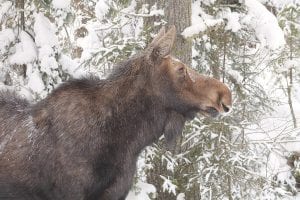According to the 2016 aerial moose survey, Minnesota’s moose numbers seem to have stabilized, but because they are not bouncing back, the low numbers continue to worry wildlife researchers.
Results of the 2016 Minnesota Department of Natural Resources (DNR) survey, conducted from January 4-15, predominantly in St. Louis, Lake and Cook counties, estimate there are about 4,020 moose in Northeastern Minnesota, up 570 from 2015 estimates.
This falls within the statistical range of the last three-year estimates of 3,450 in 2015; 4,350 in 2014; and 2,750 in 2013.
Wildlife researchers believe the 2013 count was low because it was a heavy snow year and moose were harder to spot.
Whatever the feeling is about this year’s calculation, the DNR notes that the statistical range for 2016 varies and places Northeastern Minnesota’s moose population as high as 5,180 or to as low as 3,230.
DNR wildlife research manager Lou Cornacelli cautioned that all wildlife population surveys have inherent degrees of uncertainty, and that long-term trend and population estimates give researchers a much clearer picture than one year samplings.
While the precipitous drop in numbers has seemed to stabilize, researchers continue to work to unravel the puzzle of what caused the moose population to fall from an estimate of 8,840 in 2006 to the 2016 tally, a 55 percent drop.
“Moose are not recovering in northeastern Minnesota, said Glenn DelGiudice, Ph.D. moose project leader for the DNR. “It’s encouraging to see that the decline in population since 2012 has not been as steep, but longer term projections continue to indicate that our moose population decline will continue.”
Since 1960 the DNR has conducted an annual moose survey in northeastern Minnesota. Flying low in a helicopter, a spotter counts moose over 52 randomly selected plots of 13 square miles.
In 2013 the state began a moose mortality research project, which focused on collaring moose and tracking their activity. Moose had been radio-collared in the past, but in this study, since halted, the state used collars outfitted with GPS tracking devices which sent researchers six locations of each moose each day, as well as the ambient outside air temperature. If a moose didn’t move for six hours, a text message was sent to researchers every 30 minutes for the next six hours so DNR staff could track the animal.
The goal was to locate moose that die within 24 hours so they can be retrieved and studied to determine the cause of death.
Three years after scientists began collecting data from GPS-collared moose via satellite, a clearer picture has begun to emerge.
A recent look at the adult moose mortality data reveals disease and predators have been causing moose to die at an alarming rate. Of the 47 adult collared moose studied over the last three years, two-thirds died from health related causes and wolves killed one-third of them, but biologists note that 25 percent of those moose were sick and made easy picking for the wolves.
But it’s not just wolves taking moose. Parasites, winter ticks, liver fluke, brain worm and other disease seem to be causing great problems for this much-loved species.
Another theory is that climate change impacts have caused moose to stress and not eat enough in the winter, which causes them to be weak and more susceptible to disease, wolves and ticks. Moose are adapted to survive in cold temperatures and recent warm winters have been linked to moose decline in northwestern Minnesota where fewer than 20 are believed to survive after a high of more than 1,000 two decades ago. Wildlife researchers believe that may be happening in northeastern Minnesota.
In a two-year (2013-2014) calf mortality study, more than 70 percent of the calves died within the first year of life. Minnesota Governor Mark Dayton ended the GPS calf/adult collar program in 2015 because he felt too many animals were dying from the process of being captured and collared.
Following the 2013 count the DNR also cancelled the moose hunting season, which hasn’t been resumed.
In an effort to help moose rebound, the Minnesota Deer Hunters Association and Nature Conservancy, along with other groups, have planted more than 1 million trees, giving them a food source that ended when logging was largely shut down in the last decade. It’s a first step and may already be helping, but more study needs to take place.
The Fond du Lac Band of Lake Superior Chippewa and 1854 Treaty Authority contribute funding and personnel for the annual aerial survey, and Grand Portage wildlife researcher Dr. Seth Moore has spent more than six years conducting a study into what is causing the decline in moose numbers in northeastern Minnesota, sharing the Band’s research with the state.



Loading Comments